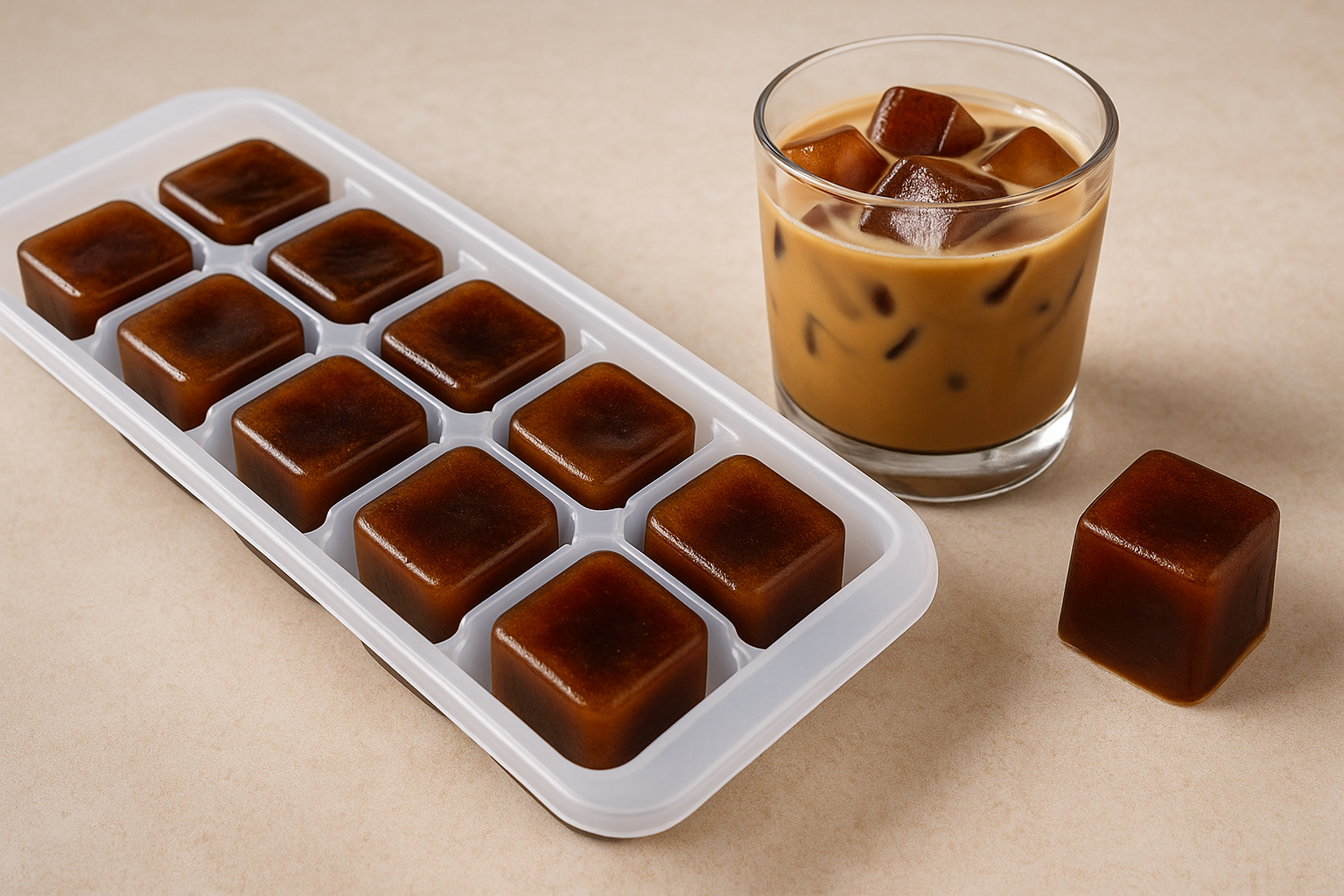If you’ve ever made iced coffee at home, you’ve probably faced one major problem—it gets watery too quickly.
Regular ice cubes melt and dilute your carefully brewed coffee, leaving it weak and flavorless halfway through the glass.
But there’s an easy fix: coffee ice cubes. These frozen blocks of flavor not only keep your drink cold but enhance it as they melt. In this article, you’ll learn exactly how to make coffee ice cubes, creative ways to use them, and why they’re a total game changer for home brewers.
Why Use Coffee Ice Cubes?
Standard ice cubes made from water serve only one purpose: chilling your drink. But they also come with a big downside—they water it down.
Coffee ice cubes, on the other hand:
- Keep your coffee strong and flavorful
- Can be made from different coffee types for unique results
- Add an aesthetic and gourmet touch to your iced drinks
- Are incredibly easy to make
They’re especially helpful for anyone who enjoys cold brew, iced lattes, or even coffee-based cocktails.
What You’ll Need
Making coffee ice cubes is simple. Here’s what you need:
- Freshly brewed coffee (choose your strength)
- Ice cube trays (standard or silicone molds)
- Optional: sweetener, milk, spices, or flavored syrups
- Freezer space and a sealed container (for storage after freezing)
Step-by-Step Guide to Making Coffee Ice Cubes
Step 1: Brew Your Coffee
Start with a coffee you enjoy drinking. You can use:
- Cold brew for a smooth, low-acid flavor
- Drip coffee for a balanced taste
- Espresso for a rich, intense cube
Brew slightly stronger than normal to compensate for the melting effect in the final drink.
Step 2: Let It Cool
Allow the coffee to cool to room temperature before pouring it into trays. Hot coffee may crack some plastic trays or make the freezing process uneven.
Step 3: Pour into Trays
Carefully pour the cooled coffee into your ice cube tray. For easier handling and aesthetics, consider:
- Silicone molds for easy release
- Fun shapes (stars, spheres, etc.) for visual appeal
- Mini cubes for faster melting and distribution
Step 4: Freeze
Place the tray flat in your freezer for at least 4–6 hours, or until fully frozen. Once solid, transfer the cubes to a freezer-safe airtight container to prevent freezer burn or flavor contamination.
Step 5: Use as Desired
Drop 3–5 cubes into a glass, pour in your iced coffee or milk, and enjoy a drink that stays strong until the last sip.
Creative Variations of Coffee Ice Cubes
Coffee ice cubes are versatile. Here are ways to customize them based on your favorite drinks:
1. Sweetened Cubes
Add sugar, simple syrup, or condensed milk to the brew before freezing. Perfect for iced lattes and desserts.
2. Flavored Cubes
Try mixing in:
- Vanilla or hazelnut syrup
- Cinnamon or nutmeg
- Cocoa powder for mocha cubes
These are ideal for cold mochas or flavored cold brew.
3. Milk-Based Coffee Cubes
Mix milk and espresso to create creamy cubes that slowly turn your iced coffee into a latte.
4. Cold Brew Cubes
Freeze concentrated cold brew for a smooth flavor that enhances any iced drink, even those with milk or cream.
5. Espresso Shot Cubes
Perfect for espresso tonics or as a base for iced coffee cocktails. Intense flavor and deep color.
How to Use Coffee Ice Cubes in Drinks
Here are some ideas to get the most out of your coffee ice cubes:
Iced Coffee
Use your regular brew over coffee ice cubes. As they melt, the flavor intensifies rather than fades.
Iced Latte
Add cubes to a glass of milk or plant-based milk (almond, oat, soy). The result: a slowly evolving, creamy iced coffee.
Coffee Smoothies
Toss a few cubes into the blender with banana, peanut butter, and milk for a coffee-flavored energy smoothie.
Affogato Twist
Use espresso or cold brew cubes instead of hot espresso poured over vanilla ice cream. It’s like a frozen affogato.
Coffee Cocktails
Great for drinks like an Espresso Martini or a spiked iced latte. They keep your drink cold without sacrificing strength.
Storage Tips
- Store frozen cubes in zip-top freezer bags or sealed containers
- Label with date and coffee type
- Use within 2–3 weeks for best flavor
Coffee can absorb odors from the freezer, so keep them sealed tight.
Tips to Maximize Flavor
- Brew your coffee fresh and strong
- Avoid flavored or low-quality beans
- Use filtered water to prevent off-tastes
- Don’t use stale or reheated coffee—it’ll taste worse when frozen
How Many Cubes Per Drink?
Typically, 3 to 5 cubes per 300ml (10 oz) drink is enough. You can experiment depending on:
- Cube size
- Strength of your brew
- Personal preference
Benefits Beyond Flavor
Coffee ice cubes aren’t just about taste—they also improve consistency, presentation, and enjoyment.
- Keep the experience enjoyable to the last sip
- Help prevent waste by repurposing leftover brewed coffee
- Impress guests with a professional-style iced coffee presentation
Final Thoughts: Level Up Your Iced Coffee
If you love iced coffee, coffee ice cubes are a small change that brings huge rewards. They’re easy to make, customize, and store—and they completely transform the drinking experience. From lazy summer mornings to post-work pick-me-ups, your iced coffee deserves to stay bold from beginning to end.
Start freezing your favorites today and never sip watered-down coffee again.
Now generating a realistic horizontal image to match this article.
Imagem criada
Avalie esta imagem
Now moving on to the final article in this batch:
The Best Milk Alternatives for Coffee: Taste and Frothing Compared
The Best Milk Alternatives for Coffee: Taste and Frothing Compared
For coffee lovers who avoid dairy—whether due to lactose intolerance, dietary preference, or ethical reasons—plant-based milk alternatives have become a staple. But not all non-dairy milks behave the same when paired with coffee. Some curdle in hot espresso, others overpower the flavor, and a few simply refuse to froth. So which are the best milk alternatives for coffee? This comprehensive guide compares taste, texture, and frothing ability of the most popular options, so you can choose the one that suits your brew and lifestyle.
Why Choosing the Right Plant-Based Milk Matters
The milk you add to your coffee affects:
- Flavor – it should complement, not dominate the coffee.
- Texture – especially important in lattes and cappuccinos.
- Temperature stability – some milks curdle when heated or mixed with acidic espresso.
- Frothing – critical for milk-based drinks like lattes, flat whites, and cortados.
Not all plant milks are created equal, and different brands can vary widely. Still, some options consistently perform better than others in the coffee world.
1. Oat Milk
Taste: Slightly sweet, creamy, and neutral—great for enhancing coffee without overpowering it.
Texture: Smooth and rich, closely mimics whole milk.
Frothing: Excellent. Oat milk froths very well and holds its foam, especially barista editions.
Pros:
- Balanced flavor
- Great microfoam for latte art
- Popular in specialty cafés
Cons:
- Can be more expensive
- Some brands contain oils and stabilizers
Best For: Lattes, cappuccinos, and flat whites.
2. Almond Milk
Taste: Nutty and slightly bitter, can compete with the coffee’s natural flavors.
Texture: Thin unless fortified or thickened. Some versions feel watery.
Frothing: Difficult to froth unless labeled as “barista blend.” Prone to separating or curdling.
Pros:
- Low-calorie option
- Widely available
- Pairs well with flavored coffee
Cons:
- Often separates in hot coffee
- Weak foam structure
Best For: Iced coffee, smoothies, or drip coffee with a splash.
3. Soy Milk
Taste: Mild and beany, sometimes sweet depending on the brand.
Texture: Thicker than almond milk, similar to 2% dairy milk.
Frothing: Froths well with some training. Barista blends perform significantly better.
Pros:
- High protein content
- Creates smooth foam
- Affordable and common
Cons:
- May curdle with acidic coffee
- Slight aftertaste
Best For: Hot drinks like lattes and macchiatos.
4. Coconut Milk
Taste: Strong coconut flavor that can dominate the coffee.
Texture: Creamy, sometimes oily depending on the fat content.
Frothing: Froths poorly unless mixed with other plant milks. Can produce large bubbles but lacks microfoam.
Pros:
- Rich and indulgent
- Good in cold brews and tropical-inspired drinks
Cons:
- Not neutral—will change coffee’s flavor
- Poor stability when heated
Best For: Iced lattes, dessert-style drinks, and smoothies.
5. Cashew Milk
Taste: Mild, creamy, and subtly nutty.
Texture: Thick and smooth, similar to whole milk.
Frothing: Froths okay, but doesn’t hold shape long. Works better cold than hot.
Pros:
- Creamy feel without strong flavor
- Blends well with espresso
Cons:
- Harder to find than almond or oat
- Inconsistent frothing
Best For: Cold coffee drinks, espresso blends.
6. Rice Milk
Taste: Sweet and watery, with a light cereal-like flavor.
Texture: Very thin and not creamy.
Frothing: Minimal froth, separates easily.
Pros:
- Hypoallergenic
- Naturally sweet
Cons:
- Watery texture
- Not suitable for lattes or cappuccinos
Best For: Drip coffee or iced coffee with a splash of milk.
7. Pea Protein Milk (e.g., Ripple)
Taste: Neutral and mild, doesn’t overpower coffee.
Texture: Creamy and similar to dairy milk.
Frothing: Froths well—especially in barista blends.
Pros:
- High protein content
- Stable in hot drinks
- Low allergen risk
Cons:
- Limited availability
- Some versions can taste chalky
Best For: Steamed drinks, protein-rich coffee beverages.
Frothing Performance Comparison
| Milk Type | Frothing (1–5) | Latte Art Potential | Stability in Hot Drinks |
|---|---|---|---|
| Oat Milk | 5 | Excellent | Very Stable |
| Almond Milk | 2 | Poor | Low |
| Soy Milk | 4 | Good | Medium-Stable |
| Coconut Milk | 2 | Poor | Low |
| Cashew Milk | 3 | Medium | Medium |
| Rice Milk | 1 | Very Poor | Unstable |
| Pea Milk | 4 | Good | High |
Best Milk Alternatives for Specific Coffee Drinks
- Latte: Oat or soy milk
- Cappuccino: Oat milk
- Flat White: Oat or pea milk
- Cold Brew: Almond or coconut milk
- Espresso Macchiato: Pea or soy milk (minimal curdling)
- Iced Coffee: Almond, rice, or coconut (depending on flavor preference)
Tips for Better Results with Plant-Based Milk
- Use Barista Blends: These are formulated to resist curdling and foam better.
- Don’t Overheat: Keep milk under 60°C (140°F) to avoid curdling or burning.
- Steam in Short Bursts: For better microfoam and texture.
- Shake or Stir Before Pouring: Some milks settle and need mixing.
Final Thoughts: Find Your Perfect Pairing
Plant-based milks have come a long way—and so have your options. Whether you’re after rich foam, mild flavor, or a specific dietary benefit, there’s a milk alternative that fits your coffee routine. Try a few and see which brings out the best in your beans, whether you’re pulling espresso or sipping cold brew on a summer day.
With the right plant-based milk, you’ll never miss dairy again.

Marcelo Oliveira is a coffee enthusiast and content creator specializing in barista skills, brewing methods, equipment reviews, coffee-related health insights, and fascinating curiosities from the coffee world. With a deep passion for every step of the brewing process, he turns technical knowledge into accessible and engaging content for both beginners and seasoned coffee lovers. Marcelo’s goal is to help readers appreciate the full experience of coffee—from bean to cup.
